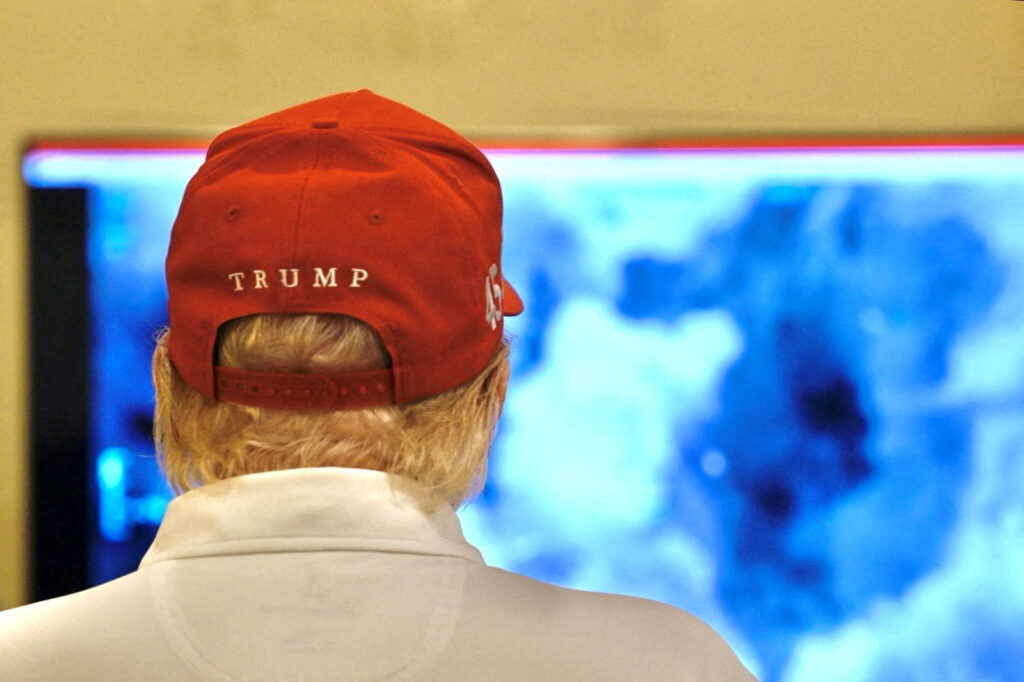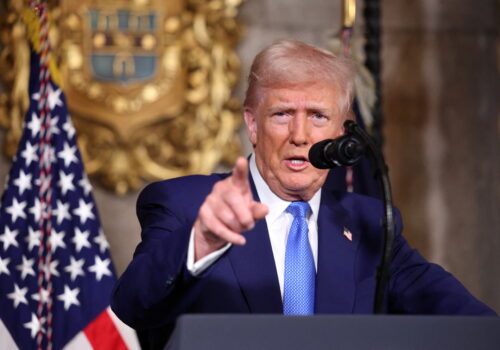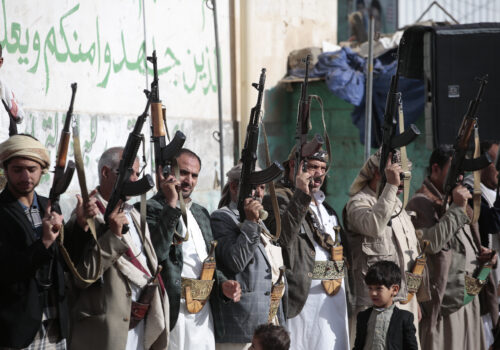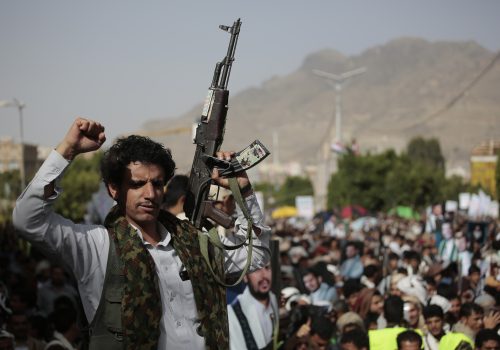If you were confused by the Telegraph article on Iran “abandoning” the Houthis, you’re not alone. That narrative is precisely the kind of strategic ambiguity Iran has long relied on, inviting speculation while concealing intent. But this moment isn’t just about misinformation. It’s about signaling. The anonymous official leaking the headline appears to be offering the perception of restraint, not to change facts on the ground, but to buy time, test reactions, and shape how those facts are read in Washington, Riyadh, and beyond.
While Iran may have repositioned some personnel as the Telegraph claims, there is no credible evidence of pulling back support from the Houthis or a wholesale “abandonment.” Tehran still has its ambassador in Sanaa who advises the Houthis and maintains a significant covert operational presence in Yemen through the Islamic Revolutionary Guard Corps (IRGC), specifically its Quds Force. Moreover, General Abdul Reza Shahlai, a senior Quds Force commander who has been active in Yemen since at least 2011–2012, serves on the Houthis’ Jihadis council. The IRGC’s presence in Yemen is linked to its so-called “6000 branch,” which oversees operations across the Arabian Peninsula.
The “abandonment” narrative is not an isolated distortion. In Iraq, the recent Reuters reporting suggests militias might disarm, but mentions they’re considering “turning the groups into political parties and integrating them into the Iraqi armed forces”—effectively institutionalizing rather than diminishing their influence. It’s part of a broader choreography of plausible deniability that Iran has perfected across the region. In Syria, its presence was labeled “advisory” as it built entrenched military outposts. In Iraq, it blurred the line between state and militia. In Yemen, the illusion has matured: Iran no longer needs to defend its role. Others do it for them.
Tehran’s alleged storyline by this anonymous source is likely a leak to test reactions, meant to simultaneously accomplish three key goals: it gives the US administration a symbolic win, creates space for Iran to maneuver for sanctions relief and its nuclear ambitions without concessions, and sends a message to international observers that it is capable of restraint. It’s not nearly anywhere near surrender and acknowledgment of Iran’s limits with its proxies; it’s simply diplomacy by the headline.
The Houthi-Iran dynamic
When confronted with the Telegraph article, a senior Houthi official mocked the idea that Iran had ever deployed personnel to Yemen. Houthi foreign minister Jamal Amer explicitly stated to Reuters that “Iran is not interfering in our decision, but what is happening is that it mediates sometimes.” There was no mention of Iranian withdrawal of support, only continued alignment within Iran’s “Axis of Resistance” network. For the Houthis, who boast of their role in that axis, admitting dependence would signal weakness. Denying the premise reinforces a fiction that serves both sides.
Ironically, Tehran has long claimed it plays no direct role in Yemen, a position that strains credulity given the Houthis’ advanced weaponry, military training, and tightly aligned messaging. Just this March, Supreme Leader Ali Khamenei asserted the Houthis act independently while simultaneously embracing them as core members of the “Axis of Resistance.” With Iran deliberately obscuring its operational control and coordination, the Houthis’ proxy status has become a geopolitical Rorschach test, revealing more about observers’ biases than the facts on the ground. This calculated ambiguity is not a bug but a feature of Iran’s regional strategy.
For close observers of Yemen-Iran dynamics, one of the most persistent fictions has been the idea that Tehran attempts to restrain the Houthis. This narrative, repeated by Western officials and analysts alike, casts the Houthis as impulsive or unruly, as if they were acting against Iran’s advice rather than as part of its regional architecture. It’s an unsubstantiated claim, but a deeply useful one. It builds the myth of Houthi autonomy while shielding Iran from the consequences of its alignment.
A “victory” for Trump? The danger of misreading strategic signals
Trump’s approach seems to have generated new calculations in Tehran. After the president ordered “decisive and powerful military action” against Houthi targets in Yemen in March 2025, warning that “Hell will rain down” if attacks continued, Iranian officials responded with their characteristic mix of defiance and caution. This escalatory rhetoric, coupled with the Trump administration’s “more aggressive approach” that targets a broader range of Houthi assets and personnel, has created strategic pressure that Iran struggles to counter. While Tehran publicly maintains a posture of defiance, any attempt to withdraw IRGC personnel from Yemen simply suggests a reluctance to expose high-value assets to US firepower.
Iranian state media portrays Trump as an impulsive, unstrategic figure whose actions are driven by ego and spectacle rather than coherent policy. He is depicted as lacking both military and political understanding, engaging in reckless interventions not out of strength, but out of bluster and desperation. As such, the “abandonment” narrative hands him a neatly packaged win, potentially reducing pressure on Tehran and its proxies. But the notion that Iran abandoned the Houthis without restraining them exposes the dishonesty of Tehran’s position. Trump has said he will hold Iran responsible for “every shot fired by the Houthis,” making a simple withdrawal meaningless. A real disengagement would require Iran to stop Houthi attacks. Instead, Tehran seeks credit for restraint while allowing its proxy to continue. It cannot have things both ways.
Despite this logical contradiction, the misinformation campaign has gained traction in media circles, with many uncritically repeating the abandonment narrative while Iran maintains operational support for Houthi forces.
The new proxy consortium: Russia, China, and Iran.
While much has been made of Tehran’s supposed withdrawal, equally important is understanding what’s filling the perceived vacuum. Growing Russian and Chinese influence offers the Houthis alternative channels of support that complement, rather than replace, Iran’s backing. Reports indicate increasing cooperation with Moscow, including Russian military experts in Sanaa advising on weapons and targeting.
China, with economic stakes in the Red Sea through its Belt and Road Initiative, maintains a diplomatic balance, calling for de-escalation while positioning as a mediator. Rather than a pivot away from Iran, these ties reflect a Houthi diversification strategy, creating a more complex web of support that’s harder for the United States to disrupt.
Instead of seeing this as a zero-sum game between Tehran, Moscow, and Beijing, one might consider how these powers complement each other: Iran offers ideological cohesion, media support, and a commanding role; Russia, military expertise and diplomatic cover; China, economic depth and global legitimacy.
This complementary support structure is evident in the material flows to Houthi territory. In March 2025, Yemeni authorities intercepted eight hundred Chinese drone propellers en route to the Houthis through the Sarfayt border crossing with Oman in a route long exploited by the IRGC throughout the Yemeni conflict. Earlier, in August 2024, officials also seized Chinese-manufactured hydrogen fuel cells, a technology that enables drones to fly higher, longer, and with greater precision. Analysts suggest these enhanced drones could identify targets over one hundred miles away, dramatically increasing the Houthis’ strike range.
Meanwhile, China and Russia have quietly secured safe passage through the Red Sea, a privilege not extended to most other countries, whose vessels remain subject to Houthi attacks.
Perhaps more revealing, on March 22, 2025, Moscow-based influencers and pro-government Chinese personalities were spotted in Sanaa, attending a solidarity conference with Palestine at the Houthis’ invitation. Their presence was not incidental, it was a signal of a growing diplomatic alignment between these powers, and a carefully staged one at that.
SIGN UP FOR THIS WEEK IN THE MIDEAST NEWSLETTER
What we’re witnessing in Yemen’s north is an expansion and sophistication of the Houthi support network. The emerging trilateral cooperation between Iran, Russia, and China, in this nearly overt fashion, is a strategic investment in the Middle East that these countries are making for the long-term future and stability of their authoritarian power.
All this gives the Houthis an advantage as they manage a complex web of like-minded alliances, each bringing complementary resources: Iranian ideological alignment and strong geopolitical backing, Russian military expertise, and Chinese economic and technological capabilities. This model of distributed sponsorship may well represent the future of proxy warfare in the region, creating redundancy, resilience, and expanded capability while diffusing attribution and accountability.
What next?
Meanwhile, Iran’s strategic ambiguity conceals mounting anxiety over Trump’s unpredictability and stated hostility toward the regime. When US forces struck Houthi positions in March, IRGC Commander Salami issued contradictory statements, threatening “decisive and destructive” responses while disclaiming control over his Yemeni proxies. As usual, this reveals how Iran projects strength rhetorically while carefully avoiding any direct confrontation that might imperil regime survival.
This delicate balancing act has become increasingly difficult as Iran’s gray zone strategy has collapsed under the weight of its own economic dysfunction and political disarray. Facing economic pressure at home and the decimation of regional allies like Hezbollah and Hamas, Iran cannot afford direct confrontation with the United States, yet cannot abandon its proxy strategy without losing face. The “abandonment” narrative gives Iran a face-saving offramp, appearing to respond to US pressure while preserving its most critical strategic assets and influence.
For Washington, it’s not just easy to stop Iran without disassociating from the risks that could befall the entire region. The former president Ronald Reagan’s doctrine of countering adversarial influence with sustained presence and alliance-building has long since eroded. Despite the Trump administration’s firm stance on Iran through the 2015 nuclear deal withdrawal and maximum pressure campaign, Tehran has managed to leverage the subsequent policy shifts between administrations to expand its regional influence through proxies like the Houthis, who now effectively control critical maritime chokepoints and threaten global shipping lanes with minimal consequences.
Rather than interpreting Iran’s narrative shift as a break, we might see it as a manufactured contradiction, a disfigured present that invites misreading while preserving power. What looks like restraint is often just a symbolic resolution in place of strategic change. This is not disengagement. It’s tactical storytelling.
Fatima Abo Alasrar is a Senior Analyst with the Washington Center for Yemeni Studies and a Board Member of Peace Track Initiative. She can be found on X at @YemeniFatima.
Further reading
Mon, Apr 7, 2025
Can Donald Trump “completely annihilate” the Houthis in Yemen?
MENASource By Emily Milliken
The Trump administration’s Houthi strategy will require a more nuanced approach that deepens these non-military components.
Fri, Mar 14, 2025
The United States’ Houthi terrorist designation unmasks Russia’s Yemen strategy
MENASource By
Yemen's Houthi rebels have become a tool of foreign powers, shifting from an Iran proxy to a Russian asset.
Fri, Jan 6, 2023
Want peace in Yemen? First, restore the balance of power.
MENASource By
Rather than giving in to the Houthis’ latest demands and withdrawing their support for pro-government forces, the UAE and Saudi Arabia should attempt to restore a balance of power in negotiations.
Image: FILE PHOTO: U.S. President Donald Trump looks on as military strikes are launched against Yemen's Iran-aligned Houthis over the group's attacks against Red Sea shipping, at an unspecified location in this handout image released March 15, 2025. White House/Handout via REUTERS THIS IMAGE HAS BEEN SUPPLIED BY A THIRD PARTY./File Photo



